Cleric In Iran Fuming Over Arson Attack On Khomeini’s Statue
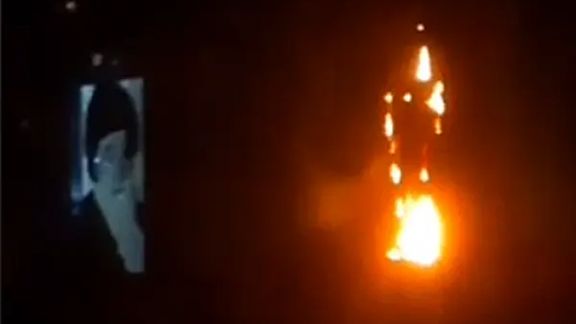
A senior cleric in Qom expressed anger over unknown people setting fire to a statue of the founder of the Islamic Republic, Ruhollah Khomeini in the city.

A senior cleric in Qom expressed anger over unknown people setting fire to a statue of the founder of the Islamic Republic, Ruhollah Khomeini in the city.
A video of a Khomeini’s statue in flames was circulated on social media in recent days, prompting Qom Friday Prayers leader Alireza Arafi to condemn the act and threaten those behind it.
He described it as "vicious" and said security officials would definitely follow up on this issue. He called it as part of a chain of conspiracies that are aimed at undermining the Islamic Republic.
Qom – along with Mashhad, is the most religious city in Iran, home to the largest Shiite seminary and many hardliner clerics.
As poverty is soaring in Iran and the regime keeps failing to deliver on its promises, such acts of political vandalism are growing across the country.
In February, another statue of Khomeini in the city of Ardestan in the province of Esfahan was destroyed, several days before a recorded message against Khomeini and Supreme Leader Ali Khamenei was broadcast on the public announcement system in Mashhad’s bazaar.
In January, a memorial statue of Qasem Soleimani, the commander of Iran’s Revolutionary Guard Qods Force, was set on fire in the central city of Shahrekord hours after it was erected.
According to a new online survey by a Netherlands-based institute, over 60 percent of Iranians want regime change or "transition from the Islamic Republic".
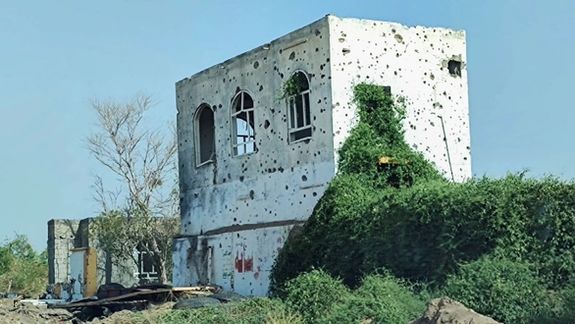
The warring sides in Yemen's seven-year conflict have for the first time in years agreed a two month nationwide truce.
The halt to hostilities would also allow fuel imports into Houthi-held areas and some flights operating from Sanaa airport, the UN envoy said on Friday.
The UN-brokered deal between a Saudi-led coalition and the Houthi group backed by Iran is the most significant step yet towards ending a conflict that has killed tens of thousands and pushed millions into hunger.
UN special envoy Hans Grundberg said the truce would come into effect on Saturday at 7 p local time (1600 GMT) and could be renewed with consent of the parties. Saturday marks the start of the Muslim holy month of Ramadan.
"The aim of this Truce is to give Yemenis a necessary break from violence, relief from the humanitarian suffering and most importantly hope that an end to this conflict is possible," Grundberg said in a statement, adding he would press for a permanent ceasefire.
Yemen's economy and basic services including health have collapsed, leaving 80% of the population of around 30 million reliant on aid.
UN Secretary-General Antonio Guterres said the truce "must be a first step to ending Yemen’s devastating war", urging the parties to build on the opportunity to "resume an inclusive and comprehensive Yemeni political process".
Houthi rebels launched a fierce drone and missile attack last week on Saudi oil installations, as behind the scenes talks were most probably taking place.

The United Nations Human Rights Council has extended the mandate of the Special Rapporteur of the Human Rights in Iran Javaid Rehman.
Member states voted to extend Rehman’s role for a further year at the 49th session of the Human Rights Council (HRC) Friday, along with similar mandates for North Korea and Myanmar.
The council requested Rehman, a law professor at London’s Brunel University, to submit a report to the UN General Assembly at its 77th session in September 2022, and to the HRC’s 52nd session in February-March 2023.
“The renewal of this mandate is essential in light of the persistence of a pattern of serious human rights violations and international crimes committed by Iranian authorities, as extensively documented by civil society monitors and by the Special Rapporteur,” read a letter to the HRC from Iranian and international human rights organizations.
Later on Friday, Foreign Ministry Spokesman Saeed Khatibzadeh rejected the UN resolution on the human rights situation in the country, saying it was drafted by Britain and other Western countries based on groundless claims and incorrect information and is “devoid of any legal validity”.
Rehman was appointed as the third rapporteur on Iran July 6, 2018, following Asma Jahangir and Ahmed Shaheed. The HRC had re-established the mandate of a rapporteur on Iran’s human rights situation in 2011 after terminated an earlier one in 2002.
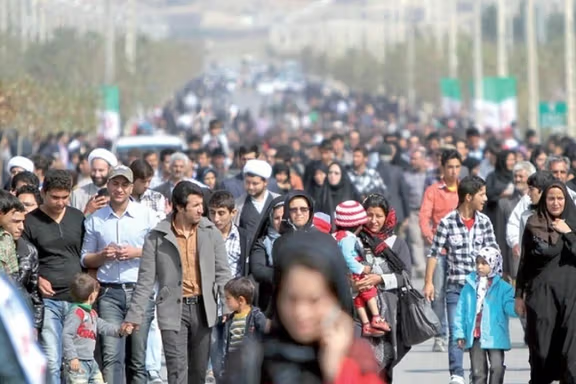
A new online survey by a Netherlands-based institute has found that over 60 percent of Iranians want regime change or "transition from the Islamic Republic".
The survey by Gamaan found that 41% of respondents want the overthrow of the Islamic Republic and 21% prefer "structural changes and a transition from the Islamic Republic". On the other hand, only 18% of the respondents said they were happy with the political system and wanted to preserve the principles and values of the Islamic Revolution which overthrew the Shah of Iran and his Pahlavi Dynasty in 1979.
Gamaan focuses on measuring attitudes in Iran and they shared their latest findings with Persian-speaking media abroad on Friday. The institute has published their survey results also in English in the past.
Prince Reza Pahlavi who has lived all his adult life in exile was the most popular in a list of civil and political figures mentioned in the Gamaan survey with 39% of respondents choosing him over all others including the current rulers of the country.
Over 65% of respondents said they had a positive view of the Prince's grandfather Reza Shah Pahlavi (1878-1944) who founded the Pahlavi Dynasty, while 23% evaluated him negatively. His son Mohammad Reza Pahlavi (1919-1980) who was overthrown by the Islamic Revolution of 1979 was viewed positively by 64% of respondents, while 28% judged him negatively.
Prince Reza Pahlavi was followed by hardliner President Ebrahim Raisi with 17%, and former President Mahmoud Ahmadinejad with 12% of support. Former prime minister and presidential candidate Mir-Hossein Mousavi Mousavi who has been under house arrest since 2012, former reformist President Mohammad Khatami, and former moderate Foreign Minister Mohammad Javad Zarif were favored by less than 10% of the respondents.
Only 28% of respondents had a positive view of Ruhollah Khomeini (1902-1989), the founder of the Islamic Revolution, while 64% evaluated him negatively. According to Gamaan, his successor and the current supreme leader, Ali Khamenei, was favored by only 26% of the population while 66% judged him negatively.
The survey titled “Iranians’ Attitudes toward Political Systems” was carried out between February 17-27, 2022, with a final sample population of 16,850 literate Iranians aged above 19 who live inside Iran who make up 85% of the adult population.
When asked about their preferred regime type, 34% chose a “secular republic”, 22% the “Islamic republic”, 19% a “constitutional monarchy”, and 3% an “absolute monarchy”. Also, over 21% declared that they are “not sufficiently informed to answer this question”.
According to Gamaan, the results of the survey can be generalized to the target population with a credibility level of 95 percent. The survey employed multiple chain referral to select the sample population, but there has been no peer review yet of the methodology used in selecting the target audience.
Comparison with previous surveys reveals no drastic changes occurring over the past year, Gamaan said.
About 65% of respondents said they favored “nationwide strikes”, 65% “protest campaigns in social media”, 52% “engaging in civil disobedience” to bring about political change in the current milieu of Iran.
Iran witnessed several widespread protests during 2021, including protests over water shortage in Khuzestan and Esfahan while teachers, workers, nurses, and pensioners had to resort to recurring protests demanding improvement in their livelihoods. Security forces dispersed peaceful gatherings in most cases and even resorted to using lethal force in Khuzestan in July and in Esfahan in November.
The results of the survey showed that 88% of the population favor a "democratic political system” while 67% of the population are against “having a system governed by religious law”. Only 28% evaluate favored a religious governing system.
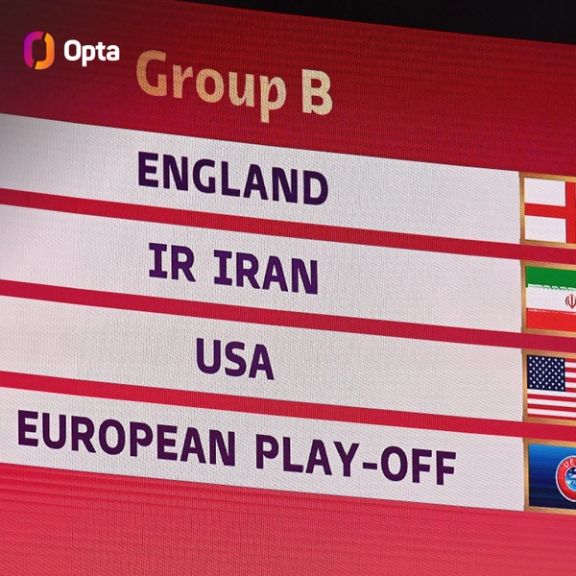
Iranian men’s national football (soccer) team has been drawn in Group B of Qatar FIFA World Cup along with the United States and England.
The drawing ceremony was held in Qatar on Friday, while Iran’s legendary goal scorer Ali Daei was also in attendance.
The fourth team of the group will be the winner of European playoffs that may be either Ukraine, Scotland or Wales.
The last time Iran and the US played against each other was the 1998 World Cup in France where the Iranian side beat the United States 2-1 with goals by Hamid Estili and Mehdi Mahdavikia.
According to the updated FIFA rankings, Group B is the ‘group of death’ -- the moniker that is used to describe a World Cup group that looks particularly challenging. Two teams will qualify to move up to the next round of matches.
This comes as FIFA has been urged by many people and organizations from Iran and other countries to ban Iran’s national football team from the 2022 World Cup for Iran’s recent action forcibly barring women from entering the stadium to watch a qualifying match.
A campaign on social media has seen hashtags such as #Fifabaniri (FIFA ban Islamic Republic of Iran) and others rising to the top of most-used hashtags in Persian-language Twitter.
On Tuesday, security forces denied women entry into a stadium in Mashhad, north-east Iran, to watch a FIFA World Cup qualifier between Iran and Lebanon, using pepper spray to disperse them.
A campaign inside Iran sees some former and current members of Iran's national team pledging not to enter stadiums as long as women are not allowed.
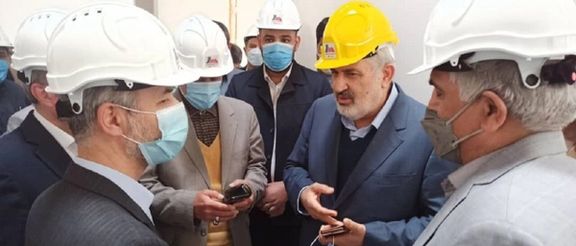
Iran’s Energy Minister Ali Akbar Mehrabian says the country has a deficit of about 15,000 megawatts in electricity production.
He announced the shortage in power production on the sidelines of a visit to a power plant construction project in the northeastern province of Razavi Khorasan on Thursday.
Mehrabian went on to say that 27 power plant units, generating about 4,500 megawatts of electricity, will enter the country’s grid this summer.
Mehrabian is in the province as part of a large delegation of ministers and officials accompanying President Ebrahim Raisi’s to his hometown, where they made a series of promises about different projects and measures to be realized this year.
According to recent data released by the ministry, power plants that were commissioned during the previous Iranian year (ended on March 20) only added a cumulative capacity of 965 megawatts to the supply network despite the announced target of adding 3,500 megawatts during the year.
Electricity consumption has been increasing in Iran because of extremely low prices, considered a subsidy in the state-controlled economy. Usage has reached to around 60,000 megawatt hours, while both power plant capacity and their fuel supply remains inadequate. At the same time, Iran exports electricity to Iraq while blackouts happen regularly at home.
Late in March, Foreign Minister Hossein Amir-Abdollahian reiterated “Iran's readiness to establish two 1,000-megawatt power stations in Lebanon”.